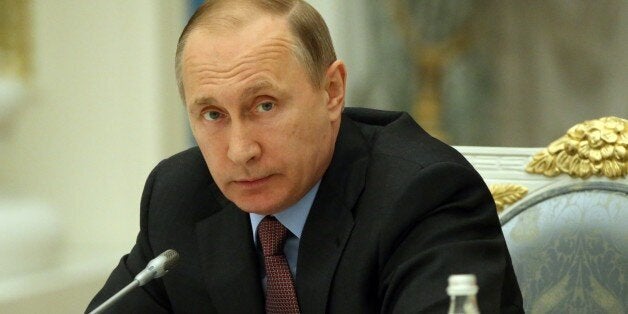
On April 1, 2016, hostilities erupted in the Armenian-majority, Azerbaijan-occupied autonomous region of Nagorno-Karabakh. Border tensions and occasional skirmishes have been regular occurrences in the disputed territory since the May 1994 ceasefire agreement, but the recent clashes were the worst outbreak of violence in two decades.
As Armenia and Azerbaijan clashed over responsibility for the flare-up and casualty statistics, Russia emerged as the conflict's principal mediator. Russian Prime Minister Dmitry Medvedev urged Armenian and Azerbaijani diplomats to agree to a swift peace agreement that would enhance the economic development of both countries and re-establish stability in the South Caucasus.
Russia's role as the lead peace negotiator in Nagorno-Karabakh is not new. Moscow coordinated the ceasefire that ended the early 1990s Armenia-Azerbaijan war, a conflict that resulted in at least 30,000 casualties.
Despite Medvdev's rhetoric, a closer examination of the dynamics of the conflict raises serious doubts about Russia's commitment to peace in the South Caucasus. To a large extent, I concur with the assessment of leading regional experts like Thomas De Waal that Russian belligerence is not the primary cause of hostilities in Nagorno-Karabakh. But three patterns of Russian conduct suggest that Putin is playing an important secondary role in destabilizing the autonomous region. This policy of systematic destabilization is aimed at enhancing Moscow's geopolitical leverage in the South Caucasus. These actions will be detailed below:
1)Russia is Arming Both Azerbaijan and Armenia Despite Escalating Regional Tensions
While Russia's alliance with Armenia is unsurprising, due to historical ties between the two countries and Armenia's membership in the Russian-led Eurasian Economic Union (EEU), the Kremlin's extensive military assistance to Turkey's principal ally in the Caucasus, Azerbaijan stands out strikingly. According to a 2015 Stockholm International Peace Research Institute Report, Azerbaijan was the second largest arms importer in Europe from 2010-2014, with 85% of those imports coming from Russia.
Since the mid-2000s, Azerbaijan has embarked on a military spending spree, officially justified by the need to combat an "illegal Armenian occupation of Nagorno-Karabakh." According to Azerbaijan's President Ilham Aliyev, Baku's annual defense budget rose 20-fold in the decade between 2005-2015, with an increase from $3 billion to $4.8 billion occurring in the 2012-2015 period alone. By contrast, Armenia spent only $447 million on defense in 2013. Russia's arms deals with Azerbaijan have destabilized the South Caucasus, by skewing the balance of power towards Baku to such an extent, that Azerbaijan can violate the ceasefire with relative impunity.
The likelihood of Azerbaijan converting its military capabilities into aggression in Nagorno-Karabakh has grown, as economic crisis fuels political instability in Baku. The collapse of the Azerbaijani manat in January 2016 fuelled mass protests against Aliyev's highly authoritarian regime. Anti-Armenian nationalism is a powerful cohesive force that Aliyev can use to rally people around his leadership during a period of economic turmoil. The president's heightened sense of vulnerability partially explains Azerbaijan's recent belligerence in Nagorno-Karabakh.
As arms shipments have enabled Azerbaijani aggression in Karabakh, top Armenian officials have scathingly criticized Russia's arms deals with Baku. Armenian Foreign Minister Edward Nalbandian insinuated in March 2015, that Moscow's arms sales to Azerbaijan contravened Russia's OSCE Minsk co-chair responsibilities, as assisting one side of the conflict in the Nagorno-Karabakh does not act in the interests of peace. Armenia's President Serzh Sargsyan has also made statements agreeing with Nalbandian's perspective.
Armenia's more limited military resources mean that its temporary focus is on maintaining the status quo and containing potential Azerbaijani aggression. But Russia's shipments of MiG-29 fighters to its base in Armenia and its $200 million military deal with Yerevan have resulted in a limited rebalance of capabilities in the conflict zone.
The Sargsyan regime continues to face pressure due to Armenia's poor economic outlook and public discontent over high corruption levels. The Panama Papers release accusing senior Armenian official Mihran Poghosian of money laundering has further eroded the Armenian public's trust in Sargsyan. In this climate of instability, a more vulnerable Sargsyan could escalate Armenia's military role in Karabakh, in order to pre-empt or retaliate against Azerbaijani aggression.
Despite numerous ceasefire violations, Russia has continued to arm both Armenia and Azerbaijan. Russian Deputy Prime Minister Dmitry Rogozin has justified this destabilizing policy, on the grounds that both Armenia and Azerbaijan are strategic partners for Moscow; and that Russia needs to fulfill its contract obligations to both countries. Russia's continued shipments of helicopters, anti-aircraft weaponry and artillery to Azerbaijan; and armored vehicles and military hardware to Armenia, will give both sides ammunition to re-inflame the conflict when their respective regimes see fit.
2)Russia Has Politicized the anti-ISIS Struggle to Strengthen its Military Position in the South Caucasus
On April 4, 2016, citing an anonymous military source, Russian state media outlet Life News reported that Azerbaijan had deployed between 50-70 Syrian ISIS troops to fight against the Armenian military in Nagorno-Karabakh. The Azerbaijani government vehemently denied these accusations, and ultimately expelled the Life News reporters who released these claims from Azerbaijan, on the grounds that they were providing false information and provoking the conflict.
Azerbaijan's strong opposition to the Life News ISIS report, was due to the reporters' insinuation that Baku lacks control over its borders and that Azerbaijan willfully allowed ISIS fighters to pass through its territory via Turkey to intervene in the conflict. The Azerbaijan Defense Ministry openly stated that the allegations were a form of "sabotage by Kremlin media" intended to raise doubts about "sovereignty and territorial integrity" of Azerbaijan.
From an objective standpoint, the notion that Azerbaijan allowed ISIS fighters to enter its territory is based on questionable logic. Azerbaijan is a secular Shia majority state that has cooperated with the US in its anti-ISIS campaign, because radical Islamists pose a threat to Aliyev's regime security. Even if ISIS fighters were deployed to Karabakh, an analysis of Azerbaijan's strategic interests demonstrates that this incident was likely little more than a one-time security breach.
Much like Putin has used the anti-ISIS struggle as a pretext to strengthen Bashar Al-Assad's authority in Syria, invoking ISIS could be an effective way to justify an expanded military presence in the South Caucasus. By making both Armenia and Azerbaijan dependent on Russia for security, Moscow can play an indispensable role in regional security, weakening the influence of its archrivals, the United States and Turkey.
3)Russian Leverage in the South Caucasus is Maximized in a Frozen Conflict Scenario
Nagorno-Karabakh, since the 1994 ceasefire has been described as a frozen conflict zone. Armenia and Azerbaijan clash extensively over territory, with occasional episodes of violence, but hostilities are always kept in checked to avoid a full-scale war. The most recent flare-up of the conflict threatened to precipitate a "hot war" in Karabakh. However, lack of will and the immediate intervention of regional powers like Iran and Russia in favor of a truce (or in Turkey's case, a cessation of hostility on Azerbaijan's terms) re-established the frozen conflict status quo within days.
One reason for the lack of progress towards tangible peace in the region is that the delicate frozen conflict equilibrium maximizes Russian geopolitical influence in the South Caucasus. Three reasons explain why a frozen conflict is so valuable for Putin. The first is that allows Russia to exert its hegemony over Armenia. The prospect of unexpected Azerbaijani ceasefire violations catching Armenia off-guard ensures that Yerevan needs a consistent flow of Russian arms. The Kremlin is happy to sell these arms to Armenia, often at discounted prices.
Russia's special treatment of Armenia has allowed it to penetrate the Armenian economy to a remarkable degree. Alexander Petersen noted in a 2013 policy analysis for the Tufts University Fletcher Security Review that Armenia relies extensively on Russian credit to purchase arms. The bilateral economic partnership accompanying the military alliance has made Yerevan highly dependent on Russian remittances. Paul Goble argues that Russia's close relationship with Armenia reciprocally expands its leverage over Azerbaijan, which is a valuable strategic partner for Moscow due to its strategic location and immense energy resources.
Second, a frozen conflict allows Russia to militarily encircle Turkey. Russia's military presence in Ukraine, Syria and Armenia means that it could, in theory swiftly strike Turkey, if Ankara threatens its security or repeats its November shoot-down of a Russian jet.
Third, resolving the Nagorno-Karabakh conflict could be a gateway for Azerbaijani membership in NATO. A 2007 diplomatic cable declassified by WikiLeaks revealed that Azerbaijan's political elites favored NATO membership. But any movement in that direction required a resolution to the Karabakh conflict.
While the ongoing arms embargo and Baku's deplorable human rights record ensure that medium-term Azerbaijani NATO accession is highly unlikely, the specter of NATO expansion inevitably provokes a strong retaliatory response from Moscow. As Aliyev has rejected membership in the EEU, Russia's next best option is to ensure that Azerbaijan remains non-aligned. Continued unrest in Karabakh makes this scenario much more likely.
In short, Putin's willingness to assert himself as an agent of peace in the South Caucasus has been vital to defusing the latest round of hostilities in Nagorno-Karabakh. But Russia's actions and grand strategy suggest that Putin's preferred strategy in Karabakh is destabilization rather than peace building. This preference, combined with the intransigence of Armenian and Azerbaijani leaders, ensures that peace in Nagorno-Karabakh, for the foreseeable future, will likely remain nothing more than a distant illusion.
Samuel Ramani is an MPhil student in Russian and East European Studies at St. Antony's College, University of Oxford. He is also a journalist who contributes regularly to the Washington Post, Diplomat Magazine and Kyiv Post, on world affairs. He can be followed on Facebook at Samuel Ramani and on Twitter at samramani2.
